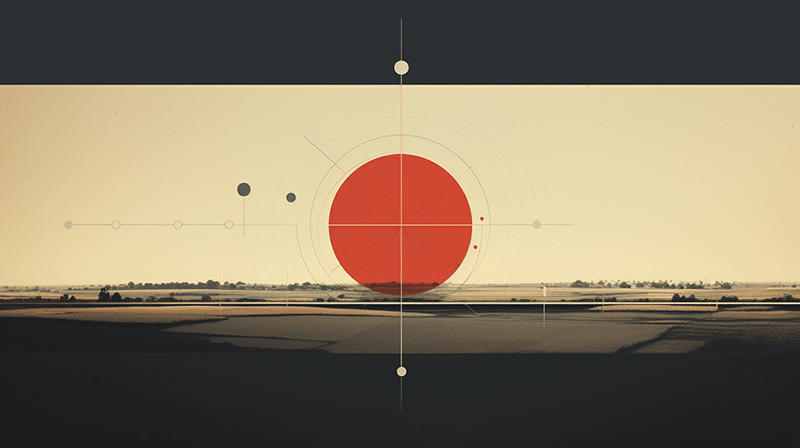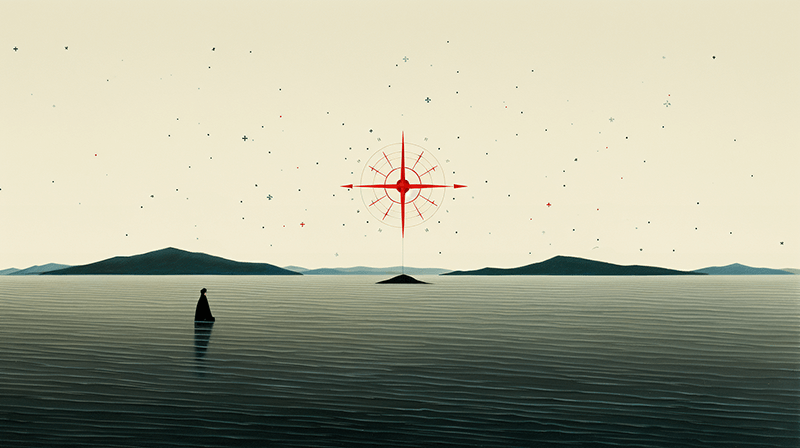If you are serious about building a life focused on creating meaningful and innovative work, then you must understand that conventional approaches to productivity designed for non-creative work will not be effective.
Creative productivity requires a different approach that promotes a balance between open-ended results and agile movement in an intentional direction.
This article will explore the meaning of “intentional direction” and how you can leverage design principles to gain clarity and confidence in your creative work.

What Are Intentions?
At its most foundational level, intentions are a commitment to action in a conscious direction.
Combined with forms of action like projects, tasks, and habits, they become a powerful tool for creating meaningful work and a life focused on creatively exploring the world around you.
How are Intentions Different from Goals?
When I discuss Intentions with creatives, they will commonly use phrases like “My intention is to be a successful artist” or “My intention is to finish a novel.”
They frame their work and ambitions using conventional goal-setting approaches and become confused and frustrated when things go astray or don’t turn out as hoped.
To be clear, Intentions and Goals are entirely different things, and to explain how, let me make you an enticing offer.
I Have a Map to Sell You!
What if I told you that for three monthly payments of $999, I could provide you with a map showing the exact steps required to accomplish your most cherished life goal?
Before you buy, there are some specific caveats.
- Any deviation from the steps and timeframes articulated in the map renders the map null and void with no refund.
- Any circumstances within or beyond your control, including but not limited to illness, natural disaster, plague, or a meteor strike that causes a deviation from the steps provided, render the map null and void with no refund.
- You must declare your most cherished life goal when you receive the map. Any alteration of that most cherished life goal after receipt of the map renders the map null and void with no refund.
- If you cannot determine your most cherished life goal at purchase, your parents, teachers, or social circle will provide one for you.
Does that sound like a good deal?
That map sounds like a fragile nightmare to me.
Conventional goal setting and planning is that map. The X on the map is the goal, and the dotted line leading to the X represents the goal planning.
The catch is, for this map to exist, the person selling you the map must have already arrived at X and tracked the steps needed to get there.
If you work in an unchanging and known environment, this might work.
The problem is that your creative life, work, career, and learning are constantly changing and, by definition, cannot be predicted with the specificity needed to map it out.
The map only comes into existence once you have already gone somewhere.
It will only show you where you have been, not where you are going.
I Have a Compass to Sell You

So, if there is no map to show us where to go, do we wander around aimlessly and hope for the best?
Absolutely not.
Instead of trying to predict hypothetical paths to hypothetical desired states of being (the path and destination on a map), you can use your creativity to imagine potential directions you might move in and then commit to moving in that direction.
Think of intentions as a powerful compass that will allow you to choose a meaningful direction to focus your time and energy.
This compass makes no false promises about where you will end up. Instead, it gives you clarity and confidence about your direction.
This increased clarity grows out of the unique qualities of intentions and how they interact with creative action.
The Benefits of Setting Intentions
Intentions are as powerful as they are because they work in confluence with the nature of creative work instead of trying to constrain it.
Their unique qualities will empower your growth and development in balanced, flexible, and personalized ways.
Intentions Put You in a State of Exploration Instead of Failure
Conventional goal setting relies heavily on predicting a hypothetical result and then working backward to determine a plan to reach that result.
You start in a position of failure and only stop being in that position once you have achieved the result.
- Did you reach the goal yet? If not, you are failing to reach your goal.
- Are things taking longer than expected? Then you are failing.
- Did something unexpected happen that forced a change in your plan? Then you are failing.
- Does the hypothetical result that you predicted not make sense anymore? Then you failed.
This focus on avoiding failure is poison for creative work, which requires a willingness to experiment with ideas and paths that may fail.
Setting intentions, in contrast, puts you in an immediate state of exploration.
Instead of spending mental and emotional resources trying to predict how to avoid not reaching your goal, you focus on the more straightforward question, “How do I move forward in alignment with my intention?”
There is no way to “fail” an intention. If you determine that the actions you focus on are out of alignment with your intentions, you adjust them and keep moving forward.
Intentions are Agile
The focus on exploration instead of avoiding failure means that your intentions and the types of actions you take in alignment with your intentions are incredibly agile.
You can experiment and adjust your intentions based on circumstance, new learning, change in interest, and new opportunities.
Altering your intentions is a sign of strength and understanding, not failure.
This level of agility and flexibility creates systems of action that are deeply connected to your personal needs and interests.
Intentions are Personalized
Unlike goals, no one can assign you intentions.
No one can tell you what your intentions are.
You can agree to be influenced by others or to align your intentions with others, but this is your system.
As you set intentions consistently, they become strong connection points between your actions.
Your projects, habits, tasks, and actions act as extensions of the intentions you set. They work in confluence with each other to empower your growth and development in ways that connect directly to your values.
Intentions Articulate your Values
The work you do, your chosen direction, and the growth you prioritize will become a meaningful articulation of your values.
Intentions represent a direct link between what you do and why you do it. Deciding where you will spend your limited resources (and where you won’t) signifies your priorities and values.
This act of prioritizing particular intentions over others is where a system of Intention Design becomes invaluable.
What is Intention Design?
The flexibility, openness, and agility of intentions are the source of their power in creative work, but those qualities also present a challenge.
How do you articulate, prioritize, and then act on your intentions?
Picking an arbitrary direction and jumping straight into action, or worse, trying to work in 1000 different directions simultaneously, is a recipe for confusion and stagnation.
The reality is that we all have way more interests than resources available to explore those interests effectively.
The limits on our time and energy necessitate navigating the inevitable dilemma of what intentions you should focus on and which you should put on hold for now.
Intention Design is the process of contemplating and articulating as many of your intentions as possible, organizing those intentions in a way that brings clarity and connection, and then prioritizing those intentions so that you can start taking action in a way that is responsive to the specific needs and constraints of your life.
It is an acquired skill set that I invite you to join me in learning with Intention Design for Creatives.
Intention Design for Creatives is a multi-format learning experience designed to teach you how to effectively leverage Intention Design and Management through an agile and custom system focused on increasing the clarity and confidence of your personal and professional direction.
Through multiple project-focused lessons and a customizable Notion template you will learn how to leverage Intention Design and Management to clarify your personal and professional direction by:
- Reflecting on your values.
- Identifying intentions connected to those values.
- Clarifying and organizing those intentions in a balanced way.
- Prioritizing which intentions to focus on.
- Beginning to execute your intentions by connecting them to systems of action.
Click the link below for more information
Intention Design for Creatives
Or
Enroll below free of charge.